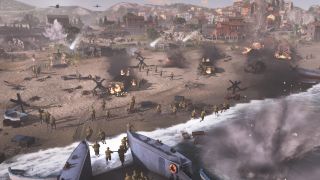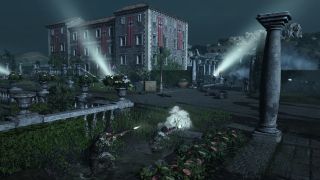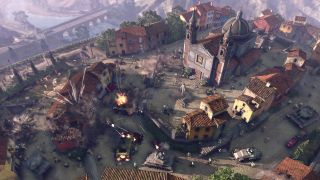Company of Heroes 3's tactical pause system is a game-changer for real-time strategy
And something other RTSs should absolutely consider.

Company of Heroes 3 is bringing with it some significant changes to the RTS titan's formula. There is, of course, the headline attraction: the extent to which it's embraced the Total War style of doing campaigns, giving the real-time romp a massive turn-based layer. But there's another system that's poised to have just as big an impact: the tactical pause.
At any point in a singleplayer battle, you can pause the action and freely explore the map. That alone is extremely convenient, giving you some breathing room and time to properly analyse the battle. The real boon, however, is the ability to order units and queue up commands while you're paused, and then see all of those orders and where your troops are going reflected in the UI. Everything you can do normally, you can do with the action frozen.
Moving units, activating your off-screen abilities, plonking down new buildings, recruiting new troops—there aren't any limits. In any single battle, there's so much going on, a huge and growing list of tasks for you to work through, so having the option to halt things and spend some time just figuring out what to do next is invaluable.

"Full tactical pause was introduced as a means to enable players of all skill-levels to engage with Company of Heroes," says executive producer David Littman. "As a real-time strategy game, we’re aware of how challenging and frenetic Company of Heroes’ gameplay can be—split-second decisions can mean the difference between your army surviving unscathed, or being cut down by enemy fire. While experienced RTS players will be accustomed to this pace of gameplay, tactical pause allows you to play the game at your own pace."
Company of Heroes has never been about how quick you are at commanding your troops; these aren't APM-obsessed games, but they are complex. The decline of the genre also means that there aren't a lot of opportunities for new players to get good, or for veteran players to dust off their skills. Unless you've continued to participate in CoH2's multiplayer, there's going to be a period of adjustment when the new game arrives. Not having the pressure of learning all the ins and outs when all hell is breaking loose makes the experience seem a lot less daunting.
If you're not worried about that, you can completely ignore the system, and while it's available in every singleplayer mode, the multiplayer will remain exclusively real-time. This will just help new or returning players get to the point where they are comfortable to fight without the assistance. And the genre needs all the new players it can get. With its reputation and a history of building multiplayer communities, I don't think Relic will struggle to find players, but even it could use a little bit of help.

Strategy and tactics games are as popular as they've ever been, but for the most part they're all turn-based or encourage use of a pause system, like Paradox's grand strategy games. People have grown used to having time to make tactical decisions. If you've been getting your fix in games like XCOM or BattleTech, you already have the tactical mindset, but it can be rough trying to apply that to a game where, in a few seconds, you could lose a whole squad on the other side of the map. That's where the tactical pause really shows how useful it can be.
The biggest gaming news, reviews and hardware deals
Keep up to date with the most important stories and the best deals, as picked by the PC Gamer team.
When you're duking it out in a high-stakes battle, having to jump to an entirely different battle with a set of troops that might have completely different capabilities is a bit of a mindfuck. With things frozen, however, you have room to analyse the situation, see what tricks your troops have, and then come up with a killer plan. With that done, you can go back to your first battle knowing that your other soldiers have a fighting chance.
It's not something that's exclusively for training, either. It might make Company of Heroes 3 more inviting for new players, certainly, but I also just found it to be a fun way to play, even as someone experienced in RTS battles. It scratches a slightly different itch and, as lead campaign designer Andrew Deneault says, it has a great payoff.

"Something I like about the tactical pause is that it's a different kind of payoff: queuing up a number of orders and then seeing them fulfilled, taking a piece of territory, using a grenade, pinning the target, flanking, breaching a structure—you can set up some of those more advanced inputs, in a way that, after you unpause, you can watch it unfold and see if it works. And if it does, it does a great payoff there."
It is immensely satisfying to set up something elaborate, painstakingly getting all of your ducks in a row, and then hopping back into the action to enjoy the fruits of your labour. It never feels simply easier, like you've got training wheels on, it just feels like a different way to put your skills to good use. Even once I feel like I can stop using it, I don't think I will. And for those who find the idea of being able to stop time in an RTS unacceptable, you can just ignore it and pretend it doesn't exist.

Fraser is the UK online editor and has actually met The Internet in person. With over a decade of experience, he's been around the block a few times, serving as a freelancer, news editor and prolific reviewer. Strategy games have been a 30-year-long obsession, from tiny RTSs to sprawling political sims, and he never turns down the chance to rave about Total War or Crusader Kings. He's also been known to set up shop in the latest MMO and likes to wind down with an endlessly deep, systemic RPG. These days, when he's not editing, he can usually be found writing features that are 1,000 words too long or talking about his dog.
Most Popular

